
PERFECT POTS FOR
SMALL SPACES
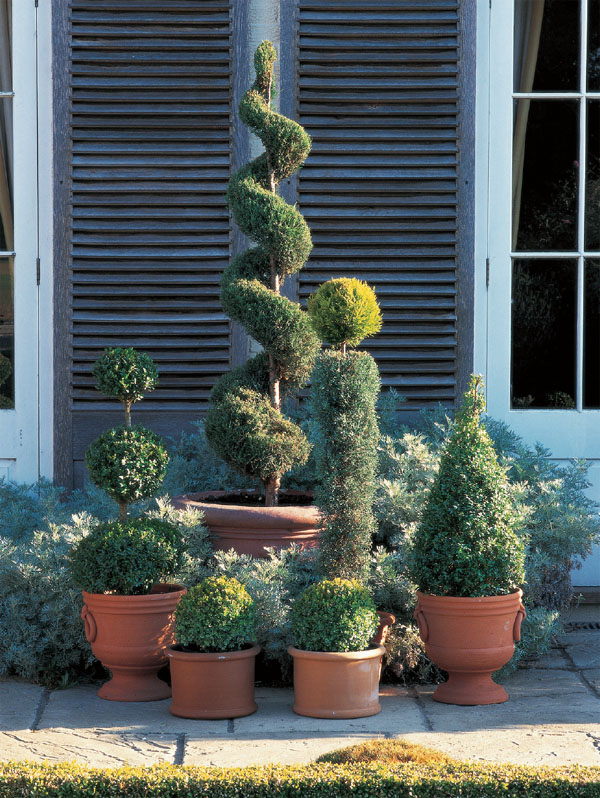
PERFECT POTS FOR
SMALL SPACES creative container gardening projects
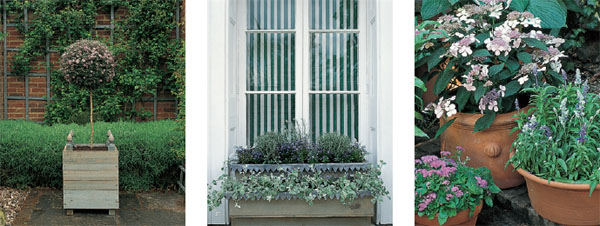
George Carter
photography by Marianne Majerus

This edition published in 2019 by CICO Books An imprint of Ryland Peters & Small Ltd 2021 Jockeys Fields, London WC1R 4BW 341 E 116th St, New York, NY 10029 www.rylandpeters.com First published in 1997 by Ryland Peters & Small, Inc. as
Gardening with Containers and reissued with amendments in 2004 as
Containers. 10 9 8 7 6 5 4 3 2 1 Text George Carter 1997, 2004 Design, illustrations, and photographs Ryland Peters & Small 1997, 2004 A CIP catalog for this book is available from the Library of Congress and the British Library. E-ISBN 978 1 78249 760 8 ISBN 978 1 78249 636 6 The authors moral rights have been asserted. All rights reserved. No part of this publication may be reproduced, stored in a retrieval system, or transmitted in any form or by any means, electronic, mechanical, photocopying, or otherwise, without the prior permission of the publisher.
Printed in China. IllustrationsMichael HillDesignerSarah WaldenProductionDavid HearnArt directorSally PowellPublishing managerPenny CraigPublisherCindy Richards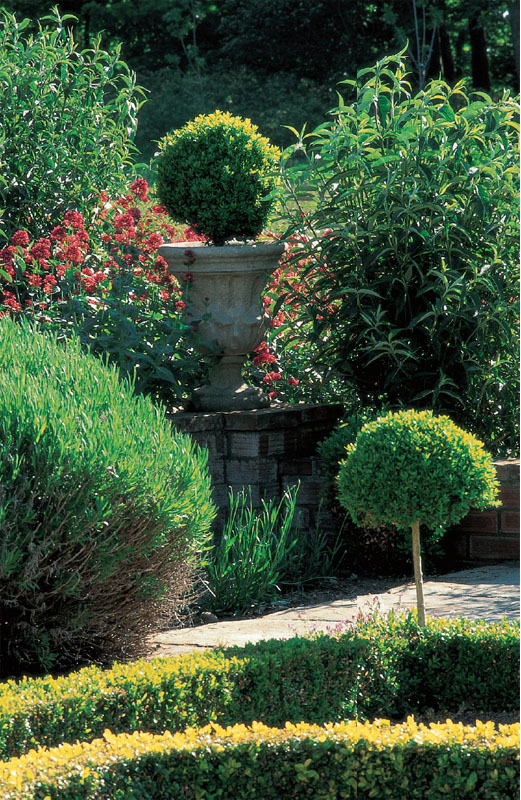
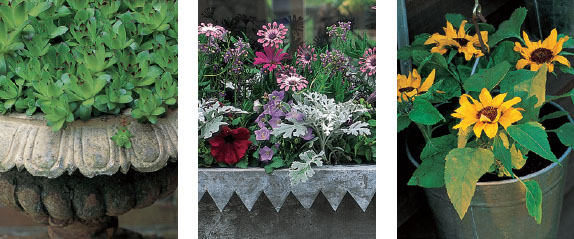 contents
contents 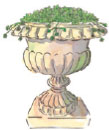 Growing plants in containers , like all gardening, is a compromise between nature and artifice. It enables you to simulate all kinds of growing conditions, place plants wherever they are wanted, grow combinations that would be impossible together in the open ground, and overwinter tender plants under cover. Container growing also makes it possible to rearrange the outside look of your home in much the same way as you might rearrange the interiorto make a radical change to its seasonal appearance, for example, or to transform a terrace for a new purpose. The projects in this book do not just look at conventional containers. There are ideas for portable plant screensthe equivalent of hedges in container gardeningfor architectural containers, and for the plant pot as gate pier.
Growing plants in containers , like all gardening, is a compromise between nature and artifice. It enables you to simulate all kinds of growing conditions, place plants wherever they are wanted, grow combinations that would be impossible together in the open ground, and overwinter tender plants under cover. Container growing also makes it possible to rearrange the outside look of your home in much the same way as you might rearrange the interiorto make a radical change to its seasonal appearance, for example, or to transform a terrace for a new purpose. The projects in this book do not just look at conventional containers. There are ideas for portable plant screensthe equivalent of hedges in container gardeningfor architectural containers, and for the plant pot as gate pier.
The projects not only show how to grow in containers but also suggest how to place plants in an overall garden or backyard design. There are innovative schemes for transforming an ordinary window box, terra-cotta pot, or wooden tubsimple changes that make containers relate to their setting. This is gardening as exterior decoration as well as horticulture. George Carter 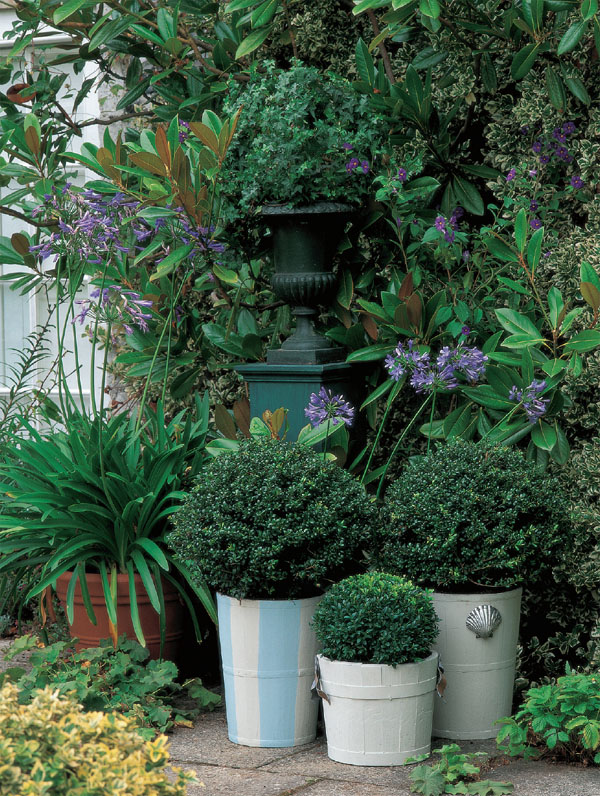 There are many variations in the color of terra cottafrom the harsh red of new machine-made pots to the softer texture prevalent in hand-thrown pots. The 18th-century English landscape gardener Humphry Repton used pale stone paints and lime washes to disguise red brick, which he thought too warm a color against the various greens of the landscape. Paints can be used for various effects, including making a container appear more or less conspicuous.
There are many variations in the color of terra cottafrom the harsh red of new machine-made pots to the softer texture prevalent in hand-thrown pots. The 18th-century English landscape gardener Humphry Repton used pale stone paints and lime washes to disguise red brick, which he thought too warm a color against the various greens of the landscape. Paints can be used for various effects, including making a container appear more or less conspicuous.
The combination of white, gray, and blue shown opposite recalls the delft ower pots much used in 17th- and 18th-century gardens to set in rows on walls or terraces. 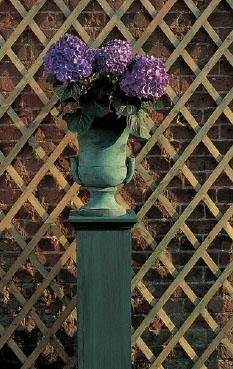 A hand-thrown urn painted dark green has patinated to a mottled bronze color. Planted with hydrangeas, the urn looks best displayed above ground level on a painted wooden plinth.
A hand-thrown urn painted dark green has patinated to a mottled bronze color. Planted with hydrangeas, the urn looks best displayed above ground level on a painted wooden plinth. 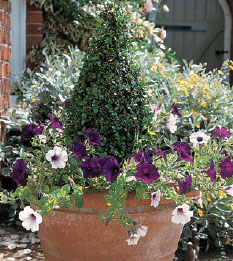 Clipped box (Buxus sempervirens) is a valuable container plant since its effect stays the same through the year. An underplanting of pink and purple petunias gives the box a colorful border in the summer owering months.
Clipped box (Buxus sempervirens) is a valuable container plant since its effect stays the same through the year. An underplanting of pink and purple petunias gives the box a colorful border in the summer owering months.  The tall and distinctive shape of these pots is emphasized by their white-painted exteriors, which read better from a distance than darker terra cotta.
The tall and distinctive shape of these pots is emphasized by their white-painted exteriors, which read better from a distance than darker terra cotta.  A wide urn-shaped pot suits the spreading habit of the variegated hosta (Hosta sieboldiana Frances Williams), whose bold architectural foliage continues throughout the growing season, making it an asset even after the owers have died off.
A wide urn-shaped pot suits the spreading habit of the variegated hosta (Hosta sieboldiana Frances Williams), whose bold architectural foliage continues throughout the growing season, making it an asset even after the owers have died off. 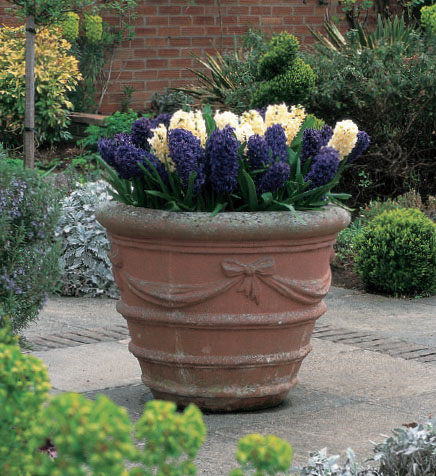 This large terra-cotta pot has been planted for early spring with dark blue and white hyacinths.
This large terra-cotta pot has been planted for early spring with dark blue and white hyacinths. 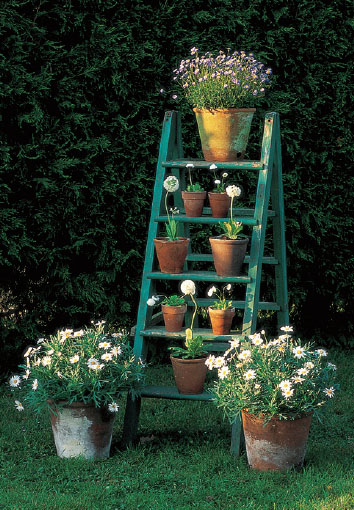 A painted stepladder makes a stage for a late spring/early summer display of felicia, drumstick primulas (Primula denticulata), marguerites (Argyranthemum frutescens), and double daises (Bellis perennis).
A painted stepladder makes a stage for a late spring/early summer display of felicia, drumstick primulas (Primula denticulata), marguerites (Argyranthemum frutescens), and double daises (Bellis perennis). 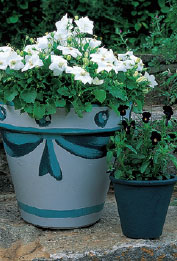 Machine-made terra-cotta pots have been painted in white, gray, and blue latex.
Machine-made terra-cotta pots have been painted in white, gray, and blue latex.  Machine-made terra-cotta pots have been painted in white, gray, and blue latex.
Machine-made terra-cotta pots have been painted in white, gray, and blue latex.
Choose plants that sit comfortably with the color of your painted pot. 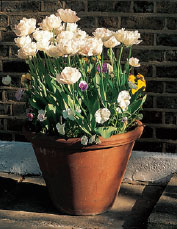 Dwarf tulips make a good spring plant for this simple terra-cotta pot. The double early Tulipa Schoonoord shown here will provide long-lasting owers in April.
Dwarf tulips make a good spring plant for this simple terra-cotta pot. The double early Tulipa Schoonoord shown here will provide long-lasting owers in April.  Many modern terra-cotta pots, especially machine-made ones, have a raw new look that can detract from the effect of an attractive planting plan. They can also look out of place next to old containers that have been softened with age. One answer is to tone down new pots using an antiquing kit that simulates a patina.
Many modern terra-cotta pots, especially machine-made ones, have a raw new look that can detract from the effect of an attractive planting plan. They can also look out of place next to old containers that have been softened with age. One answer is to tone down new pots using an antiquing kit that simulates a patina.
This project shows how to age a terra-cotta trough articially using this method, and how to display the trough effectively side by side with pots that have a natural patina. MATERIALS & EQUIPMENT 1 new terra-cotta trough 9 x 9 x 24 in (230 x 230 x 600 mm ) 2 terra-cotta pots with a natural patina 10 in (250 mm) in diameter terra-cotta antiquing kit small paintbrush scrub brush bucket 20 quarts (20 liters) potting soil pot shards 3 creeping soft grass (

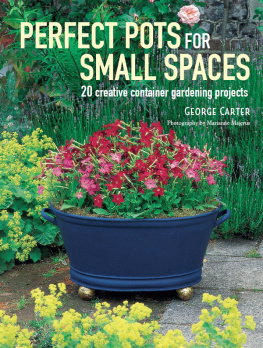

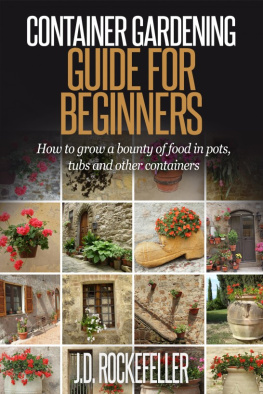
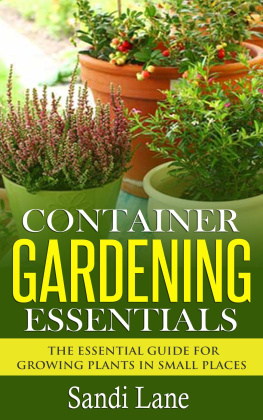
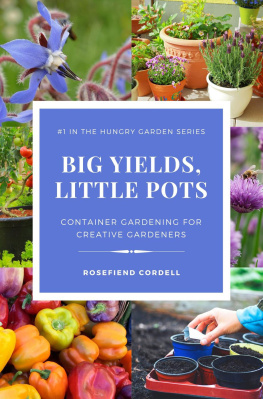
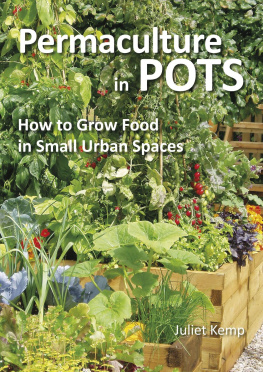

 PERFECT POTS FOR
PERFECT POTS FOR PERFECT POTS FOR
PERFECT POTS FOR George Carter photography by Marianne Majerus
George Carter photography by Marianne Majerus  This edition published in 2019 by CICO Books An imprint of Ryland Peters & Small Ltd 2021 Jockeys Fields, London WC1R 4BW 341 E 116th St, New York, NY 10029 www.rylandpeters.com First published in 1997 by Ryland Peters & Small, Inc. as Gardening with Containers and reissued with amendments in 2004 as Containers. 10 9 8 7 6 5 4 3 2 1 Text George Carter 1997, 2004 Design, illustrations, and photographs Ryland Peters & Small 1997, 2004 A CIP catalog for this book is available from the Library of Congress and the British Library. E-ISBN 978 1 78249 760 8 ISBN 978 1 78249 636 6 The authors moral rights have been asserted. All rights reserved. No part of this publication may be reproduced, stored in a retrieval system, or transmitted in any form or by any means, electronic, mechanical, photocopying, or otherwise, without the prior permission of the publisher.
This edition published in 2019 by CICO Books An imprint of Ryland Peters & Small Ltd 2021 Jockeys Fields, London WC1R 4BW 341 E 116th St, New York, NY 10029 www.rylandpeters.com First published in 1997 by Ryland Peters & Small, Inc. as Gardening with Containers and reissued with amendments in 2004 as Containers. 10 9 8 7 6 5 4 3 2 1 Text George Carter 1997, 2004 Design, illustrations, and photographs Ryland Peters & Small 1997, 2004 A CIP catalog for this book is available from the Library of Congress and the British Library. E-ISBN 978 1 78249 760 8 ISBN 978 1 78249 636 6 The authors moral rights have been asserted. All rights reserved. No part of this publication may be reproduced, stored in a retrieval system, or transmitted in any form or by any means, electronic, mechanical, photocopying, or otherwise, without the prior permission of the publisher. 
 contents
contents  Growing plants in containers , like all gardening, is a compromise between nature and artifice. It enables you to simulate all kinds of growing conditions, place plants wherever they are wanted, grow combinations that would be impossible together in the open ground, and overwinter tender plants under cover. Container growing also makes it possible to rearrange the outside look of your home in much the same way as you might rearrange the interiorto make a radical change to its seasonal appearance, for example, or to transform a terrace for a new purpose. The projects in this book do not just look at conventional containers. There are ideas for portable plant screensthe equivalent of hedges in container gardeningfor architectural containers, and for the plant pot as gate pier.
Growing plants in containers , like all gardening, is a compromise between nature and artifice. It enables you to simulate all kinds of growing conditions, place plants wherever they are wanted, grow combinations that would be impossible together in the open ground, and overwinter tender plants under cover. Container growing also makes it possible to rearrange the outside look of your home in much the same way as you might rearrange the interiorto make a radical change to its seasonal appearance, for example, or to transform a terrace for a new purpose. The projects in this book do not just look at conventional containers. There are ideas for portable plant screensthe equivalent of hedges in container gardeningfor architectural containers, and for the plant pot as gate pier. There are many variations in the color of terra cottafrom the harsh red of new machine-made pots to the softer texture prevalent in hand-thrown pots. The 18th-century English landscape gardener Humphry Repton used pale stone paints and lime washes to disguise red brick, which he thought too warm a color against the various greens of the landscape. Paints can be used for various effects, including making a container appear more or less conspicuous.
There are many variations in the color of terra cottafrom the harsh red of new machine-made pots to the softer texture prevalent in hand-thrown pots. The 18th-century English landscape gardener Humphry Repton used pale stone paints and lime washes to disguise red brick, which he thought too warm a color against the various greens of the landscape. Paints can be used for various effects, including making a container appear more or less conspicuous. A hand-thrown urn painted dark green has patinated to a mottled bronze color. Planted with hydrangeas, the urn looks best displayed above ground level on a painted wooden plinth.
A hand-thrown urn painted dark green has patinated to a mottled bronze color. Planted with hydrangeas, the urn looks best displayed above ground level on a painted wooden plinth.  Clipped box (Buxus sempervirens) is a valuable container plant since its effect stays the same through the year. An underplanting of pink and purple petunias gives the box a colorful border in the summer owering months.
Clipped box (Buxus sempervirens) is a valuable container plant since its effect stays the same through the year. An underplanting of pink and purple petunias gives the box a colorful border in the summer owering months.  The tall and distinctive shape of these pots is emphasized by their white-painted exteriors, which read better from a distance than darker terra cotta.
The tall and distinctive shape of these pots is emphasized by their white-painted exteriors, which read better from a distance than darker terra cotta.  A wide urn-shaped pot suits the spreading habit of the variegated hosta (Hosta sieboldiana Frances Williams), whose bold architectural foliage continues throughout the growing season, making it an asset even after the owers have died off.
A wide urn-shaped pot suits the spreading habit of the variegated hosta (Hosta sieboldiana Frances Williams), whose bold architectural foliage continues throughout the growing season, making it an asset even after the owers have died off.  This large terra-cotta pot has been planted for early spring with dark blue and white hyacinths.
This large terra-cotta pot has been planted for early spring with dark blue and white hyacinths.  A painted stepladder makes a stage for a late spring/early summer display of felicia, drumstick primulas (Primula denticulata), marguerites (Argyranthemum frutescens), and double daises (Bellis perennis).
A painted stepladder makes a stage for a late spring/early summer display of felicia, drumstick primulas (Primula denticulata), marguerites (Argyranthemum frutescens), and double daises (Bellis perennis).  Machine-made terra-cotta pots have been painted in white, gray, and blue latex.
Machine-made terra-cotta pots have been painted in white, gray, and blue latex.  Dwarf tulips make a good spring plant for this simple terra-cotta pot. The double early Tulipa Schoonoord shown here will provide long-lasting owers in April.
Dwarf tulips make a good spring plant for this simple terra-cotta pot. The double early Tulipa Schoonoord shown here will provide long-lasting owers in April.  Many modern terra-cotta pots, especially machine-made ones, have a raw new look that can detract from the effect of an attractive planting plan. They can also look out of place next to old containers that have been softened with age. One answer is to tone down new pots using an antiquing kit that simulates a patina.
Many modern terra-cotta pots, especially machine-made ones, have a raw new look that can detract from the effect of an attractive planting plan. They can also look out of place next to old containers that have been softened with age. One answer is to tone down new pots using an antiquing kit that simulates a patina.